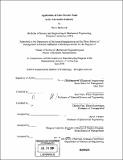Applications of color powder paint in the automotive industry
Author(s)
Barberich, Bevin, 1975-
DownloadFull printable version (5.157Mb)
Other Contributors
Leaders for Manufacturing Program.
Advisor
Joel Clark and Charles Fine.
Terms of use
Metadata
Show full item recordAbstract
Both color keyed and color specific liquid primers have been used successfully in automotive paint application, reducing the use of costly topcoat materials. Generally, color keyed primer is close in color to the topcoat and is applied to the exterior surfaces of the vehicle body. Color specific primer identically matches the topcoat material color, and can be used as a replacement for topcoat on interior surfaces. Application of color powder paint primer would provide for additional cost savings, more environment-friendly manufacturing, and higher customer satisfaction. Recent technology breakthroughs have led to the technical feasibility of applying multicolor powder paint with full reclaim and therefore 100% material utilization. The field feasibility of applying multicolor powder paint in an automotive manufacturing facility is being assessed and validated by GM. More specifically, GM has developed the GM Canister Powder Paint Delivery System to meet the challenges of color powder paint application. In anticipation of multicolor powder paint application, GM is completing its Manufacturing Systems Qualification (MSQ) Process for the Canister System. Due to the newness of the enabling technology, GM is investigating all aspects of materials, process designs, facilities, operations, and people, for the implementation of color keyed/color specific powder paint primer into new GM paint shops. Similar to GM's MSQ Process, qualification requirements in the pharmaceutical and medical device industry attest to the importance of validation in the implementation of new manufacturing technology. Beyond its technical purposes, validation can serve as a bridge between development and operation. During development, formal and relational contracts with (cont.) suppliers should be established to provide incentives for the supplier to perform throughout validation and commissioning. Involving the plant in validation along with suppliers is one means of education and thus empowerment, a key phase of organizational change as described by Professor Shoji Shiba. Leadership can use several change management techniques to help prepare the plant organization for operation of the new manufacturing technology.
Description
Thesis (S.M.)--Massachusetts Institute of Technology, Dept. of Mechanical Engineering; and, (M.B.A.)--Massachusetts Institute of Technology, Sloan School of Management; in conjunction with the Leaders for Manufacturing Program at MIT, 2004. Includes bibliographical references (p. 65-66).
Date issued
2004Department
Leaders for Manufacturing Program at MIT; Massachusetts Institute of Technology. Department of Mechanical Engineering; Sloan School of ManagementPublisher
Massachusetts Institute of Technology
Keywords
Mechanical Engineering., Sloan School of Management., Leaders for Manufacturing Program.